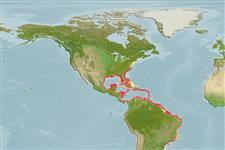Environment: milieu / climate zone / depth range / distribution range
Ecologia
marinhas; Água doce; estuarina associadas(os) a recifes; intervalo de profundidade 2 - 40 m (Ref. 58047), usually 5 - 30 m (Ref. 9710). Subtropical; 42°N - 26°S, 98°W - 14°W (Ref. 55232)
Western Atlantic: Massachusetts, USA to São Paulo, Brazil (Ref. 57756), including the Gulf of Mexico and the Caribbean Sea (Ref. 9626). Eastern Atlantic: St. Paul's Rocks and Ascension Island (Ref. 13121), Tinhosa Grande, south of Príncipe Island (L.A. Pereira (pers. comm.).
Length at first maturity / Tamanho / Peso / Idade
Maturity: Lm 32.4, range 31 - 36 cm
Max length : 128 cm TL macho/indeterminado; (Ref. 40637); common length : 60.0 cm TL macho/indeterminado; (Ref. 26938); peso máx. Publicado: 28.6 kg (Ref. 40637); Idade máx. registada: 33 anos (Ref. 115050)
Espinhos dorsais (total) : 10; Raios dorsais moles (total) : 14 - 15; Espinhos anais: 3; Raios anais moles: 8. Preopercular notch and knob weak. One of the pairs of canines in upper jaw notably enlarged, visible even when mouth is closed. Pectoral fins long, reaching level of anus. Scale rows on back rising obliquely above lateral line. Presence of a triangular bar between lower edge of eye and rear of mouth. Back and upper sides olive brown with bronze tinge, sometimes with narrow pale bars; lower sides and belly light reddish with a copper tinge. Young with a horizontal blue line below eye which breaks into a row of spots in adults.
Adults are common around rocky or coral reefs. Young are found in estuaries and occasionally enters rivers. Feed mainly on fishes and benthic invertebrates, including shrimps, crabs, gastropods and cephalopods.
Life cycle and mating behavior
Maturidade | Reprodução | Desova | Ovos | Fecundidade | Larvas
Allen, G.R., 1985. FAO Species Catalogue. Vol. 6. Snappers of the world. An annotated and illustrated catalogue of lutjanid species known to date. FAO Fish. Synop. 125(6):208 p. Rome: FAO. (Ref. 55)
Categoria na Lista Vermelha da IUCN (Ref. 130435: Version 2024-1)
Ameaça para o homem
Reports of ciguatera poisoning (Ref. 55)
Utilização humana
Pescarias: espécies comerciais; peixe desportivo: sim; Aquário: Aquários públicos
Ferramentas
Relatórios especiais
Descarregue XML
Fontes da internet
Estimates based on models
Preferred temperature (Ref.
123201): 23.2 - 28, mean 25.8 °C (based on 522 cells).
Phylogenetic diversity index (Ref.
82804): PD
50 = 0.5000 [Uniqueness, from 0.5 = low to 2.0 = high].
Bayesian length-weight: a=0.01514 (0.01339 - 0.01711), b=2.97 (2.95 - 2.99), in cm total length, based on LWR estimates for this species (Ref.
93245).
Nível Trófico (Ref.
69278): 4.4 ±0.3 se; based on diet studies.
Generation time: 11.0 ( na - na) years. Estimated as median ln(3)/K based on 1
growth studies.
Resiliência (Ref.
120179): Baixo, tempo mínimo de duplicação da população 4,5 - 14 anos (K=0.10; tm=5.5).
Prior r = 0.28, 95% CL = 0.19 - 0.42, Based on 1 data-limited stock assessment.
Fishing Vulnerability (Ref.
59153): High to very high vulnerability (66 of 100).
Nutrients (Ref.
124155): Calcium = 11.5 [5.9, 19.1] mg/100g; Iron = 0.269 [0.156, 0.499] mg/100g; Protein = 19.6 [18.0, 20.9] %; Omega3 = 0.176 [0.097, 0.305] g/100g; Selenium = 28.8 [13.9, 56.2] μg/100g; VitaminA = 96.7 [15.9, 482.1] μg/100g; Zinc = 0.254 [0.176, 0.396] mg/100g (wet weight);
